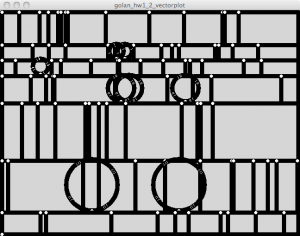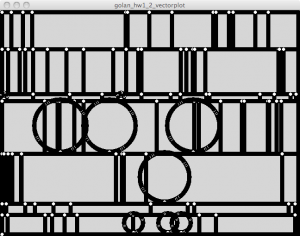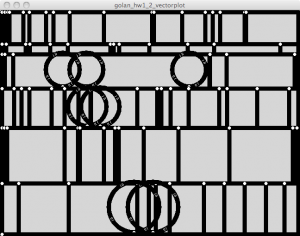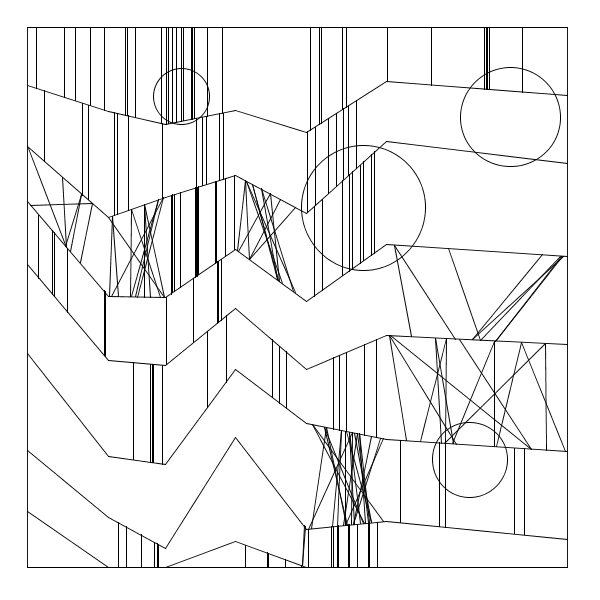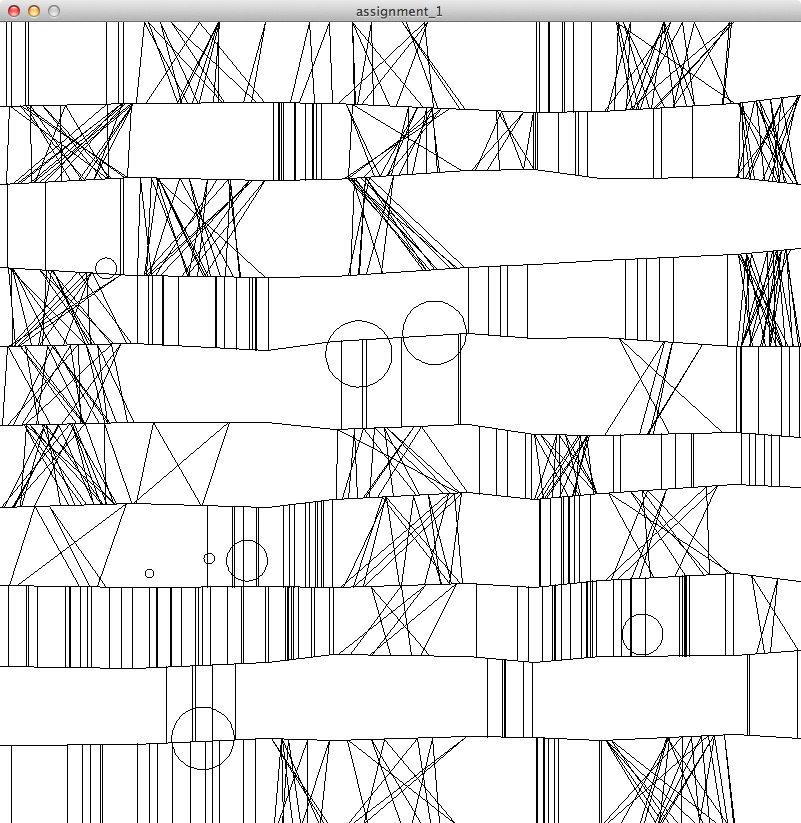KelseyLee-13-9-65
Using Processing, I tried to replicate the piece 13/9/65 Nr. 2, by Frieder Nake . By storing all of the points in arrays to access later, I was able to slow down the output so that you can see each line being drawn.
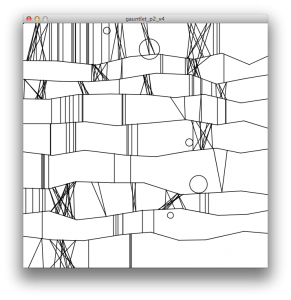

/* *Kelsey Lee 13/9/65 Nr. 2, by Frieder Nake (born 1938, Germany) *trying to replicate 13/9/65 Nr. 2, by Frieder Nake (born 1938, Germany) *randomly selects widths of columns *randomly selects where to place horizontal lines, width of segments & incline/decline of those segments *will then chose whether the block created by the column/horizontal line barriers should contain *straight lines, triangles/angles or nothing - if trianlges will choose whether to originate from top or bottom *when done, will randomly select number of circles, radius of circles and placement of circles * * ***will draw it line by line so you can see process*** */ int WIN_WIDTH = 600; int COLS; int CUBE_WIDTH_MIN = 30; int CUBE_WIDTH_MAX = 80; int[]colSegments = new int[int(WIN_WIDTH/CUBE_WIDTH_MIN)+1]; horizLine startHorizLine; horizLine endHorizLine; horizLine screenBottom; vertLineHolder vertHolder; vertLineSeg vertSeg; int ctr; int horizCtr; int yHeight; int circleCtr; int numCircles; String phase; boolean moreVert; boolean lastLine; int CUBE_HEIGHT_START_MIN = 60; int CUBE_HEIGHT_START_MAX = 100; //prior to sloping lines up or down void setup(){ size(WIN_WIDTH, WIN_WIDTH); //create window stroke(0); strokeWeight(1.5); smooth(); background(255); frameRate(40); yHeight = 0; lastLine = false; startHorizLine = new horizLine(0); startHorizLine.createTop(); screenBottom = new horizLine(WIN_WIDTH); screenBottom.createBottom(); //find column widths colSegments[0] = int(random(CUBE_WIDTH_MIN,CUBE_WIDTH_MAX)); //generates first cube width ctr=1; COLS=0; //randomly chose width of column until nearly at edge of screen, make sure last column is at least min cube width while ((colSegments[ctr-1]+CUBE_WIDTH_MIN) endHorizLine.numPts) { phase="startVertSeg"; } } else if (phase == "startVertSeg") { vertHolder = new vertLineHolder(startHorizLine, endHorizLine); moreVert = vertHolder.drawLine(); phase = "continueVertSeg"; } else if (phase == "continueVertSeg") { moreVert = vertHolder.drawLine(); if (moreVert == false) { // print("end vert seg\n"); phase = "endVertSeg"; } } else if (phase == "endVertSeg") { phase = "endHorizLineBegin"; startHorizLine = endHorizLine; //now the bottom horizontal line is the starting horizontal line for the next iteration yHeight += int(random(int(WIN_WIDTH/10),int(WIN_WIDTH/8))); //choose starting height of the next line if (lastLine == true) { phase = "circles"; } if((yHeight+CUBE_HEIGHT_START_MAX+(CUBE_HEIGHT_START_MAX/5)) >= WIN_WIDTH) { lastLine = true; } } else if (phase == "circles") { boolean endOfCircles = makeCircles(); // draw circles if (endOfCircles == true) { phase="completed"; } } if (phase == "completed"){ noLoop(); } } //make line equation from horizontal line of points and plug in known xVal to find the yVal float findYVal(int xVal, int[][]horizLine) { int ctr = 0; boolean foundY = false; float yVal =0; //find which column this xVal is in while (foundY == false) { //if true, xVal is in this column if (xVal >= horizLine[ctr][0] && xVal <= horizLine[ctr][2]) { //line eq, plug in x yVal = float(horizLine[ctr][3]-horizLine[ctr][1])/float(horizLine[ctr][2]-horizLine[ctr][0])*float(xVal-horizLine[ctr][2]) +horizLine[ctr][3]; foundY=true; } else { ctr++; } } return yVal; } /* * structure that holds a whole row's worth of vertical line segments * keeps track of which segment is being drawn & which line in that segment is being drawn. * creates many vertLineSeg structures which contain the points of all vertical lines to be drawn */ class vertLineHolder{ vertLineSeg[] segs = new vertLineSeg[COLS]; //holds vertical line segments horizLine startLine; horizLine endLine; int col; //for total number of columns int currentCol; //used later to iterate through all columns int currentLine; //keeps track of which line in a segment is being drawn //constructor vertLineHolder(horizLine startHorizLine, horizLine endHorizLine){ startLine = startHorizLine; endLine = endHorizLine; col = 0; int vertLineStart = 0; currentCol = 0; //now create segments for whole row; randomize type of vertical lines for segment while (colSegments[col+1] < WIN_WIDTH) { // print("col: " +col); int vertLineEnd = colSegments[col]; int pattern = int(random(0,8)); //0,1 -vert lines; 2,3 - triangles, 4-8 -empty makes it 5/8ths likely that nothing will be drawn //when creating vertLineSeg, call that constructor to choose lines if (pattern segs[currentCol].numLines-1) { // print("from check to next col update col \n\n"); currentLine=0; currentCol+=1; } } //if now onto a column that exceeds the number of columns present, then must go to next row to draw if (currentCol >= COLS) { // print("resetCol \n"); currentCol = 0; return false; //meaning row is done being drawn } else { return true; //row is not done being drawn } } } //a single segment of vertical lines class vertLineSeg { int numLines; int type; //type of lines int vertSeg; int vertStart; // value of starting x int vertEnd; // valiue of ending x float [][]segPts; // array of points for this segment int currentLine; //current line being drawn vertLineSeg(horizLine startHorizLine, horizLine endHorizLine, int t, int vertLineStart, int vertLineEnd) { type = t; // for straight or angled lines vertSeg = 0; vertStart = vertLineStart; // value of starting X vertEnd = vertLineEnd; //value of ending X currentLine =0; //current Line being created int lineCtr = 0; // the line being drawn numLines = int(random(1,(vertEnd-vertStart)/6)); //arbitrary 6 - total number of lines/angles for this seg,ent segPts = new float[(numLines*2)][4]; //array of points if (type == 1) { // straight lines //print(" lines: " + numLines + " | "); while (lineCtr WIN_WIDTH) { startXVal=WIN_WIDTH; //don't draw past end of screen } float yValStart = findYVal(startXVal, startHorizLine.horizPts); float yValEnd = 0; yValEnd = findYVal(startXVal, endHorizLine.horizPts); //store values segPts[lineCtr][0] = segPts[lineCtr][2] = startXVal; segPts[lineCtr][1] = yValStart; segPts[lineCtr][3] = yValEnd; lineCtr+=1; //increment to create next line } } else if (type==2) { //create angles starting from top numLines *=2; // will need to store double the amount of lines b/c 2 lines for angle // print(" lines: " + numLines + " | "); while ((lineCtr+2) WIN_WIDTH) { startXVal=WIN_WIDTH; //don't draw past end of screen } float yValStart = findYVal(startXVal, startHorizLine.horizPts); float yValEnd = 0; //create both lines of angle for (int i=0; i WIN_WIDTH) { endXVal=WIN_WIDTH; } yValEnd = findYVal(endXVal, endHorizLine.horizPts); segPts[lineCtr][0] = startXVal; segPts[lineCtr][1] = yValStart; segPts[lineCtr][2] = endXVal; segPts[lineCtr][3] = yValEnd; lineCtr+=1; } } } else if (type == 3) { // create angles starting from bottom numLines *=2; // print(" lines: " + numLines + " | "); while ((lineCtr+2) WIN_WIDTH) { startXVal=WIN_WIDTH; //don't draw past end of screen } float yValStart = findYVal(startXVal, endHorizLine.horizPts); float yValEnd = 0; for (int i=0; i WIN_WIDTH) { endXVal=WIN_WIDTH; } yValEnd = findYVal(endXVal, startHorizLine.horizPts); //ending yVals are on the top horizontal line segPts[lineCtr][0] = startXVal; segPts[lineCtr][1] = yValStart; segPts[lineCtr][2] = endXVal; segPts[lineCtr][3] = yValEnd; lineCtr+=1; } } } // print( "\n"); } } //creates a horizontal line class horizLine { int[][]horizPts = new int[10][4]; // stores points for horiz line int numPts; int minStartY; // starting Y int horizCtr; //number of horiz segments horizLine (int y){ numPts = 0; minStartY = y; horizCtr=0; } //line for top of screen void createTop() { horizPts[0][0] = horizPts[0][1] = horizPts[0][3] = 0; horizPts[0][2] = WIN_WIDTH; } //line for bottom of screen void createBottom() { horizPts[0][0]= 0; horizPts[0][1] = horizPts[0][2] = horizPts[0][3] = WIN_WIDTH; } // all other lines void createLine(){ int remainingWidth = WIN_WIDTH; //starting coordinate int startX=0; int startY = minStartY + int(random(CUBE_HEIGHT_START_MIN ,CUBE_HEIGHT_START_MAX)); //line can slope up or down only w/in the following range - so as not to allow the horizontal lines to intersect with each other int minY = startY - ((startY-minStartY)/5); int maxY = startY + ((startY-minStartY)/5); numPts = 0; while (remainingWidth > 0) { //find ending point for hte line segment int endX = startX + int(random(CUBE_HEIGHT_START_MIN ,CUBE_HEIGHT_START_MAX)); //if chosen end X coordinate is past the end of the screen, reset to end of screen if (endX > WIN_WIDTH || (endX+CUBE_WIDTH_MIN)>WIN_WIDTH) { endX = WIN_WIDTH; } //will this segment of line slope up (0) or down (1) int sign = int(random(0,1)); int endY; if (sign == 0 ) { endY = int(random(minY, maxY)); } else { endY = -1*int(random(minY, maxY)); } //store that line segment horizPts[numPts][0] = startX; horizPts[numPts][1] = startY; horizPts[numPts][2] = endX; horizPts[numPts][3] = endY; numPts+=1; remainingWidth = WIN_WIDTH - endX; ctr+=1; //end point from previous segment becomes the start of the next startX = endX; startY = endY; } } int[][] getLine() { return horizPts; } } //draw circles, xVal of center will fall inside a column boolean makeCircles() { fill(255, 0); //randomly choose number of circles if (circleCtr < numCircles) { //randomly choose radius int circleRadius = int(random(CUBE_WIDTH_MIN,200))/2; int cubeNum = int(random(1,COLS)); int xCoord= int(random(colSegments[cubeNum-1],colSegments[cubeNum])); ellipse(xCoord, int(random(circleRadius,WIN_WIDTH-circleRadius)), circleRadius, circleRadius); circleCtr++; } else { return true; } return false; } |
